The Netherlands entered this year FIFA Women’s World Cup as one of the clear favorites to qualify for the latter stage from their group. Sarina Wiegman’s side wanted to head off to a good start with a win over their first opponent, New Zealand. Leading by veteran Tom Sermanni, New Zealand knew that they need to perform their very best if they want to advance further.
At the Stade Océane, both teams played with a cautious mentality during the first minutes of the match. As the game progressed, New Zealand matched their game with the Netherlands on several occasions. They threatened Sari van Veenendaal’s goal six times with half of their attempts on target. But once again, the 2017 Women’s Euro champion stepped up at the right time to score the winning goal through Jill Roord in the stoppage time of the second half.
This tactical analysis will give you a closer look at the tactics that helped New Zealand weather the storm until the very end. Simultaneously, using statistics, this analysis will show where the Netherlands could have performed better.
Lineups
Sermanni lined his side up in a 4-5-1 with Sarah Gregorius playing as the lone striker. The most significant change for New Zealand was the return of left midfielder Olivia Chance, who had been recovered from an ACL injury. Meikayla Moore was absented as Abby Erceg and Rebekah Stott paired up in the central of the defence.
New Zealand (4-5-1, from left to right): Erin Nayler; Ali Riley (C), Abby Erceg, Rebekah Stott, C.J. Bott; Olivia Chance, Rosie White, Ria Percival, Katie Bowen, Betsy Hassett; Sarah Gregorius.
The Netherlands opted to use their usual 4-3-3 with the Arsenal quartet of goalkeeper van Veenendaal, defender Dominique Bloodworth, midfielder Danielle van de Donk, and striker Vivianne Miedema remained the core. Playing alongside Miedema as wingers were 2017 FIFA Women’s Best Player Lieke Martens and Shanice van der Sanden.
Netherlands (4-3-3): Sari van Veenendaal; Kika van Es, Dominique Bloodworth, Stefanie van der Gragt, Desiree van Lunteren; Danielle van de Donk, Sherida Spitse, Jackie Groenen; Lieke Martens, Vivianne Miedema, Shanice van der Sanden.
Netherlands’ style of play
Statistically speaking, the Netherlands should have dominated and even outplayed New Zealand. In total, they had 17 attempts towards their opponent’s goal. Surprisingly, only three of them were on target as eight were off target and six were blocked. They also held the majority of possession, which stood at 69%. 664 passes were made and 83% of them reached their destination, that’s almost three times higher than New Zealand’s number.
The Netherlands looked steady on the ball, especially when they played out from the back. Against a team who tended to defend deep, it allowed the build-up to occur high up the pitch. The centre-backs would bring the ball out of defence up into the middle third. There, she would make vertical passes towards teammates who was in an active state.
Because the Netherlands favoured a wing-oriented style of play, distributing the ball wide was usually the main option. Full-backs usually positioned themselves near the final third but were still able to provide a passing option. With the central midfielders willing to drift wide and the support from the wingers, it allowed ball circulating inside the wide spaces more easily.
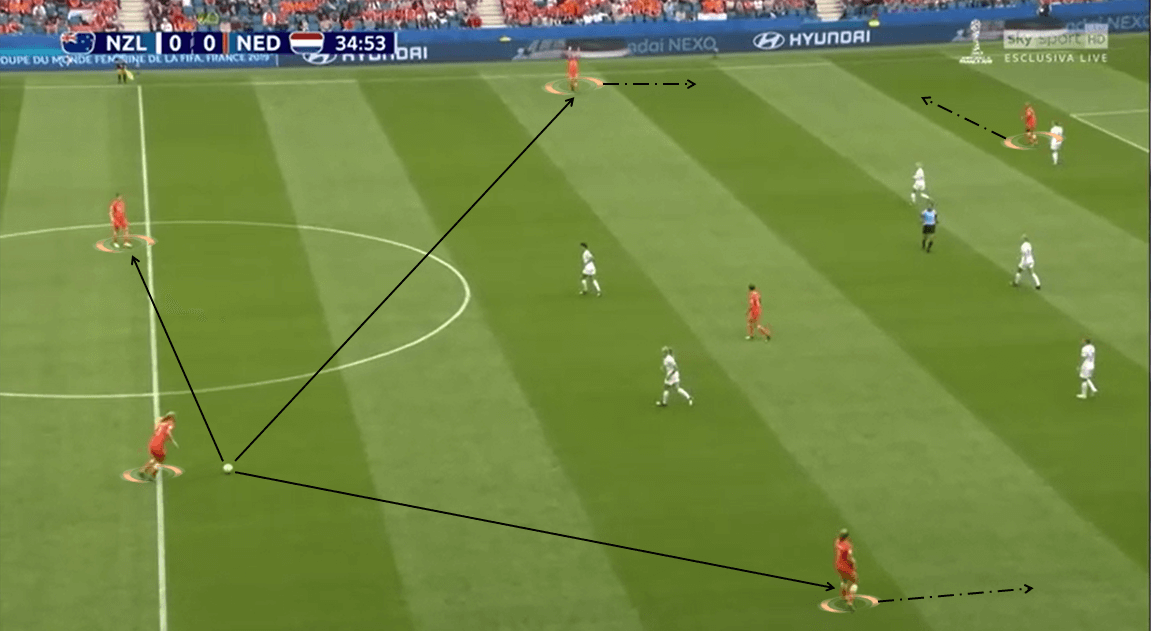
By doing so, they have created an overload inside the wide spaces. They also dragged along several of the opposition’s players and it created spaces in between the lines for other teammates to move in. If they managed to circulate the ball into the final third, they would put in a cross for players who had already arrived inside.
On the other hand, this strategy had one problem with it. When they dragged along New Zealand players, they accidentally allowed the opposition to create an overload inside the area where they had the ball or at least a 4v3 situation like below. It took them a few minutes, but they did manage to solve it. A player inside that area would move into a clear space and offering to pick the ball up. Then, she would change their attacking direction with a long pass towards the opposite full-back or winger.
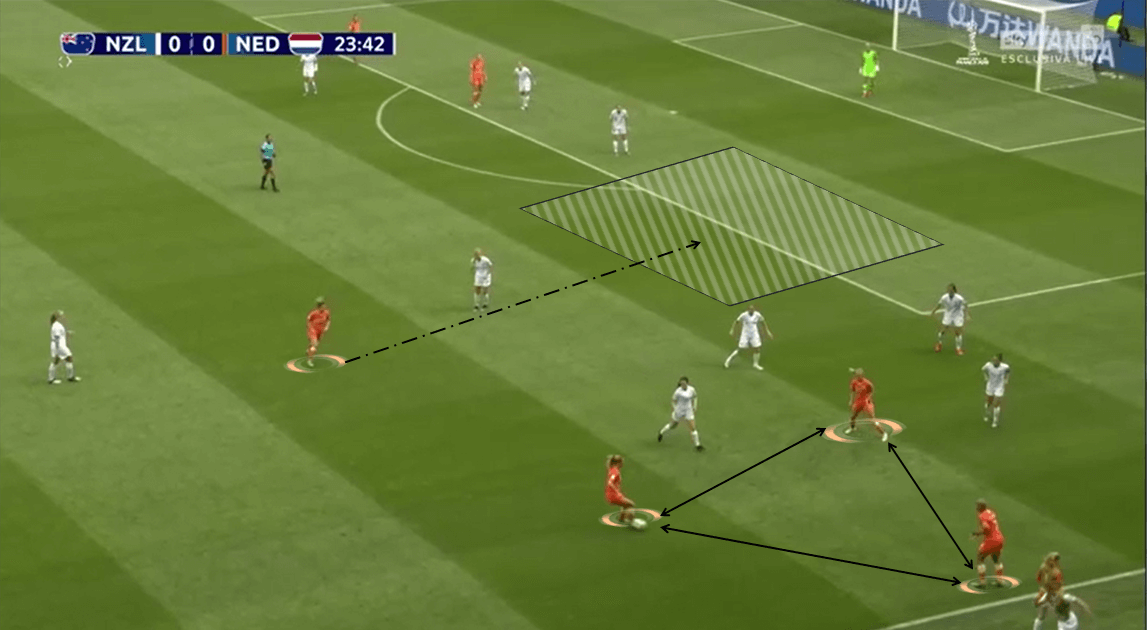
If not, they could return the ball to the centre-backs and circulate it with the surrounding teammates. This would lure New Zealand’s defensive structure to raise up and start the press. The aim was quite similar to the option above, creating spaces between the lines for players to move in.
Using long, vertical passes into those spaces, they could reach teammates who had arrived and ready to receive the ball. She would start a counter-attack by calling for supports while holding the ball up. The shot below demonstrates a similar situation. After receiving the ball from van Lunteren, Miedema paused her run and allowed Martens to move into the space behind New Zealand’s defensive line. Unfortunately, her shot went above the goal.
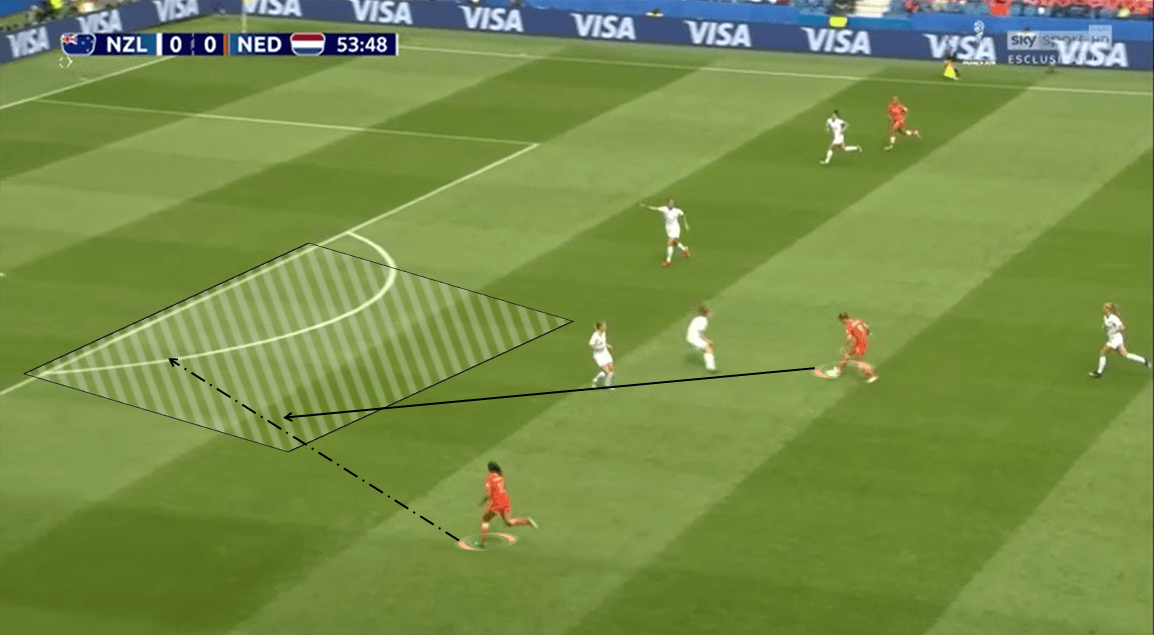
Goal conversion problem was the biggest problem that the Netherlands faced throughout the match. New Zealand’s defensive structure was very disciplined and stubborn, this prevented Wiegman’s side from creating high-quality chances. They did hit the opposition and came close to a goal in several counter-attacks, the only thing that they were lacked of luck.
But they did well when it comes to defending. They pressed aggressively and aimed to recover the ball high up the pitch. Combining with their marking system, it made New Zealand struggled when they tried to play out from the back. The strikers would mark the ball carrier and her surround passing options. They were willing to leave the far side full-back free because they have also suffocated spaces around the ball carrier.
In the shot below, we can see that they chose to leave the other centre-back free. With Miedema closing down the space between Stott and Erceg, she couldn’t to Stott’s side and make a pass towards her. While the strikers attempted to recover the ball, the midfielders marked the remaining New Zealand players. They would intercept any passes coming towards them and start a counter-attack.
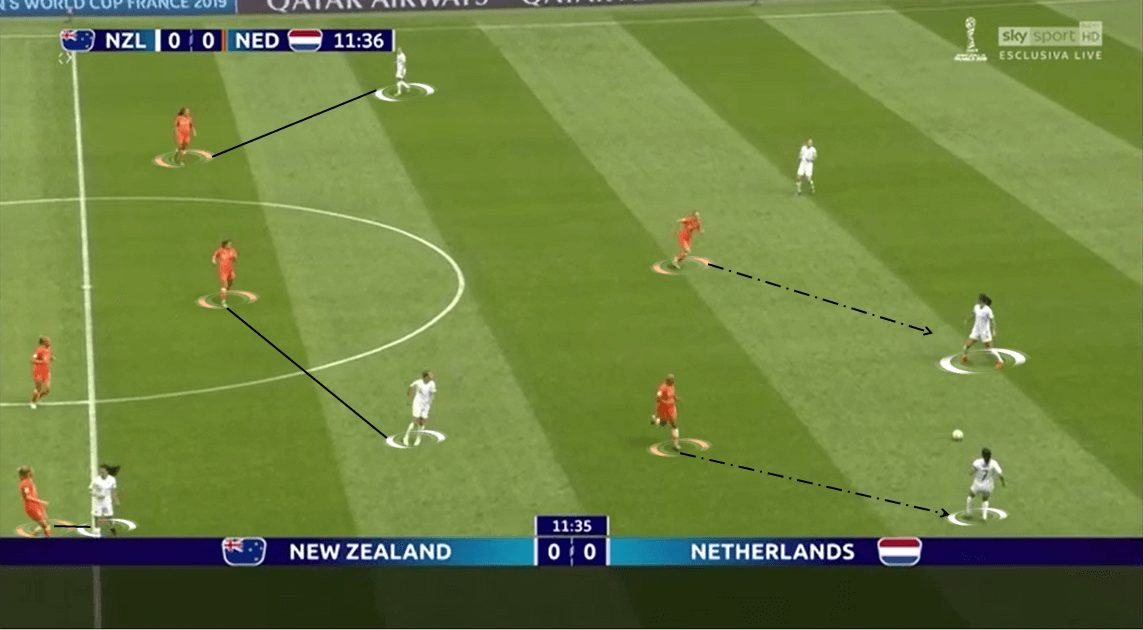
When the opposite team tried to start a counter-attack, they would form a pressure zone around the ball carrier like the shot below. Although it could create vulnerable spaces for New Zealand players to capitalise, the aggressive press that they were executing would help them win the ball back before the ball carrier could make a pass.
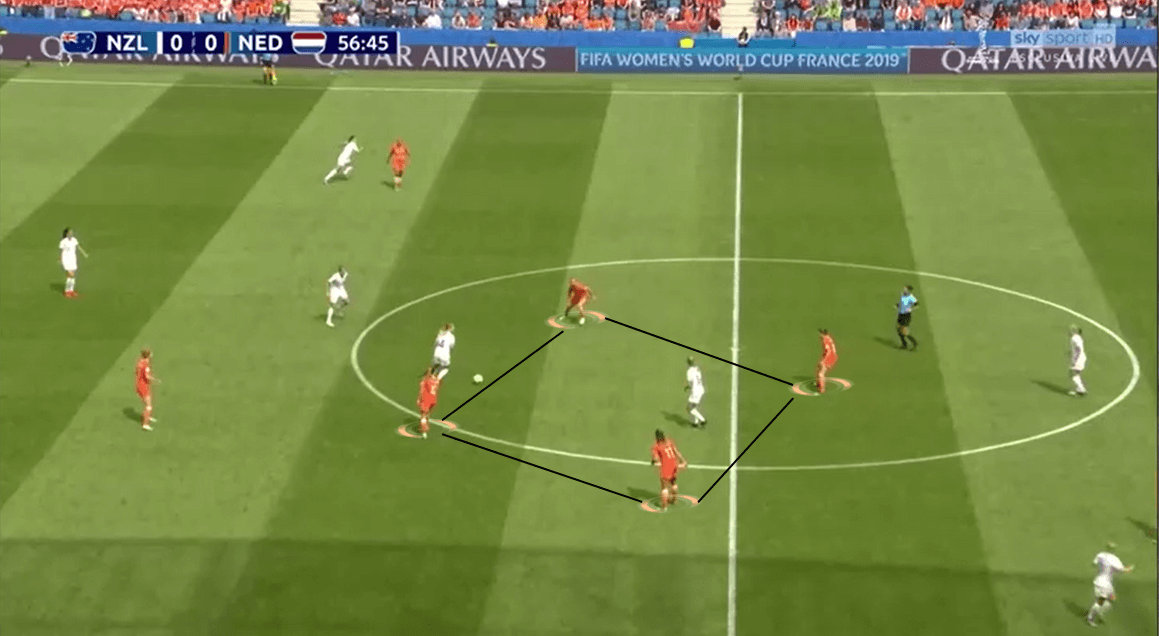
New Zealand’s defensive structure
It’s fair to say that Sermanni’s side had a very decent game. One of their biggest success from this game was to minimise Miedema and Martens’ threat using the disciplined defensive structure.
When not in possession, they formed a two-layer defensive structure that similar to a 4-4-2 formation. This allowed them to create an overload outside the 16-yard box and prevented Netherlands players to play one-two passes. They tended to stay narrow and keep the distance between players as short as possible, but also willing to shift across the pitch when the opposition distributed the ball wide.
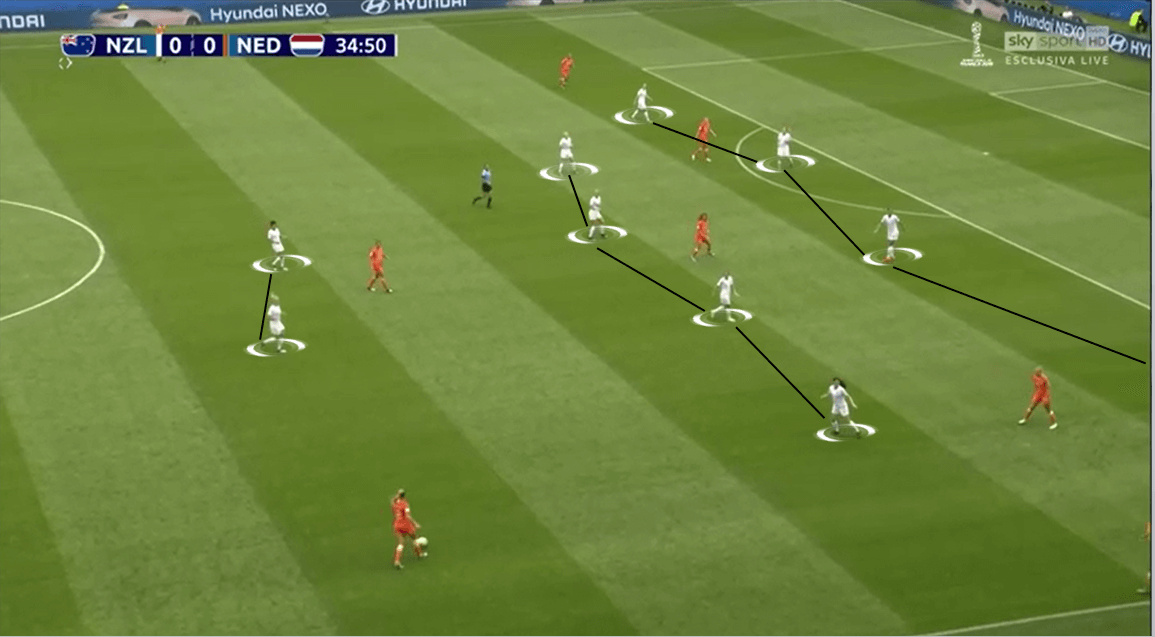
In the second half, Percival was instructed to drop in between Stott and Erceg to create a 5-3-2 defensive structure. The midfielders stayed close to each other and they would shift along with the ball. Sermanni wanted to reinforce the defence as the Netherlands have increased their pressure in order to find a goal.
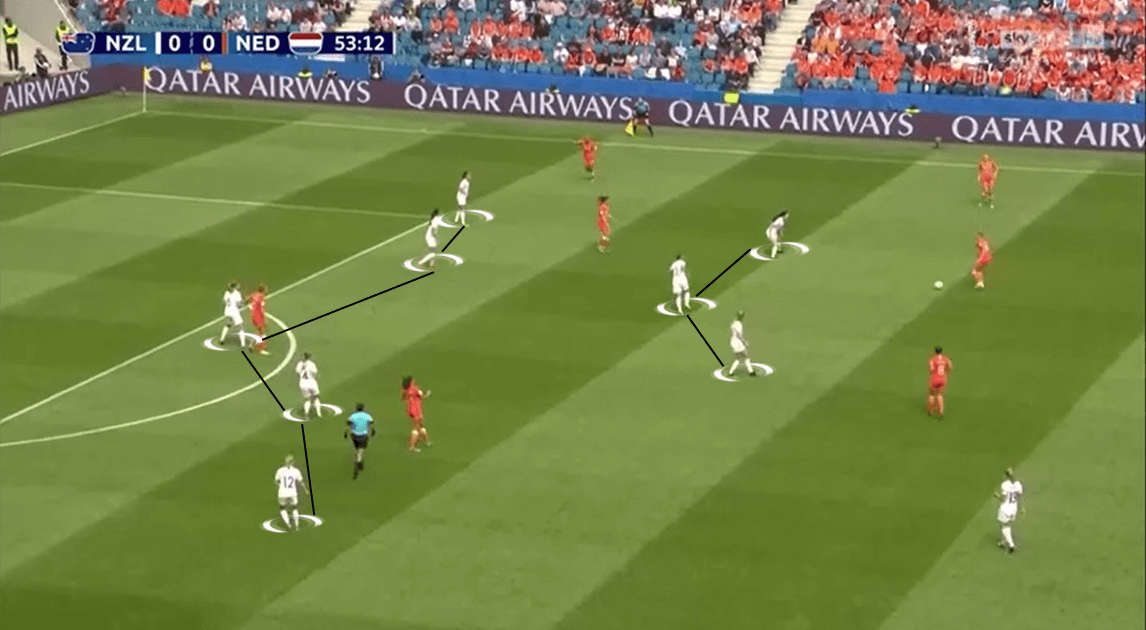
Inside the Netherlands’ half, they also tried to press and win the ball. But their conservative press allowed the opposition to bypass it and continue to hold possession. In the shot below, we can see an example of New Zealand’s press. They tended to increase pressure on the ball carrier using a 1v1 situation. Meanwhile, her teammates would locate themselves surround that area and ready to act if a pass was executed.
Another reason that led to New Zealand’s unsuccessful press was numerical superiority. As shown in the shot, they only have five players participated compared to the Netherlands’ seven. It forced some players, in this case was Gregorius, to mark more than two players at the same time. This led to the lack of focus on open spaces because their attention was put on the Netherlands’ players. As a result, Martens was free to make a pass to van Lunteren and keep their attacking momentum.
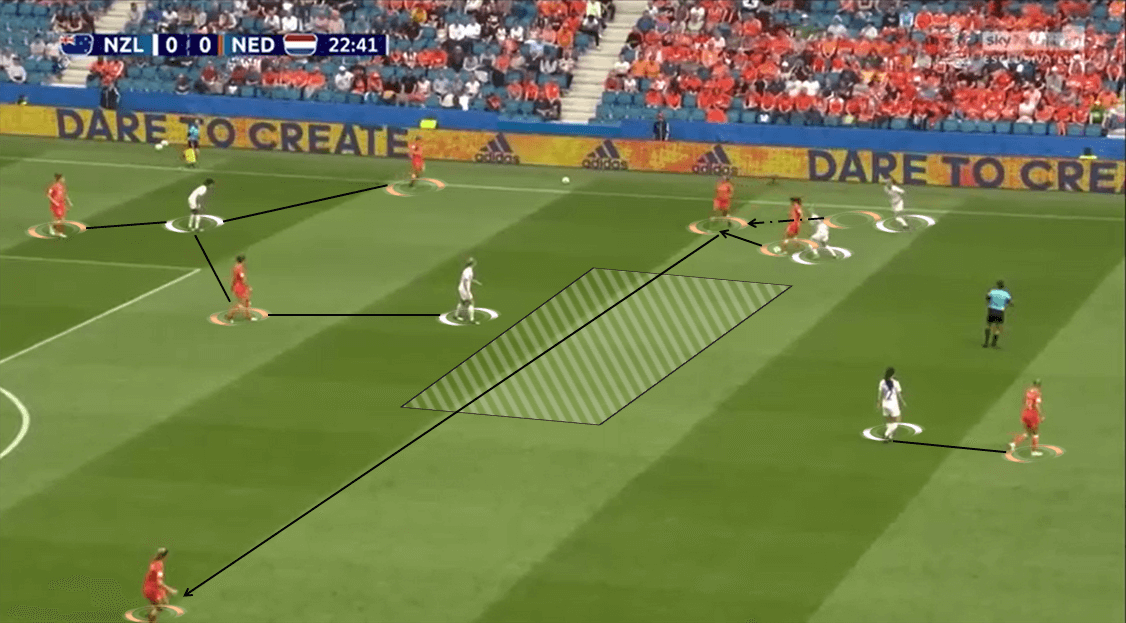
Conclusion
It was a tight match between New Zealand and the Netherlands at Le Havre. Both teams had matched each other and provided a thrilling clash. In the end, Wiegman’s side finally got what they’ve wanted before the match and it was three points. Although there were some problems that still need to be fixed, this match would help them in building the momentum to qualify for the latter stages.
For Sermanni’s side, it was not the ideal start that they’ve wanted. Nonetheless, they did show a lot of positives and came close to an upset. Two matches are still ahead of them and if they continue to perform like what they did in this match, there is a chance that they might make it out of their group.
If you are following the FIFA Women’s World Cup 2019 then you will find our FREE tactical preview magazine the perfect compliment to the tournament. You can download it HERE – each nation is previewed and we also profile their key player and young player to watch. Enjoy!

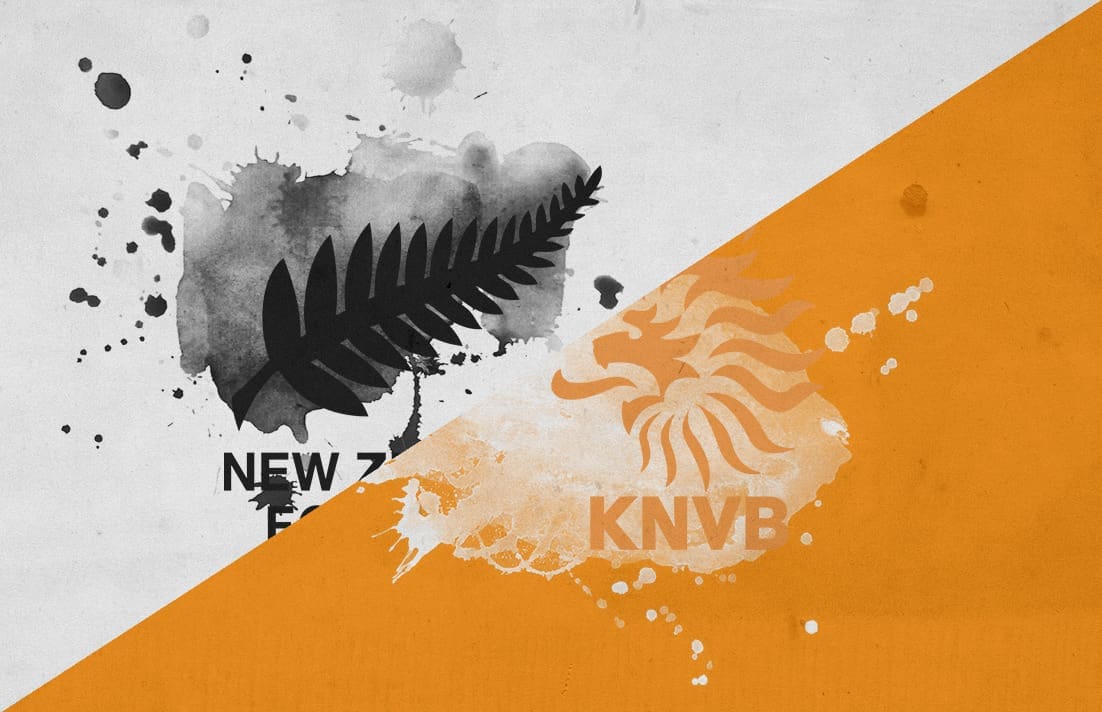


Comments